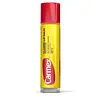What's inside
What's inside
 Key Ingredients
Key Ingredients

 Benefits
Benefits

 Concerns
Concerns

 Ingredients Side-by-side
Ingredients Side-by-side

Hydrogenated Coconut Oil
EmollientCera Alba
EmollientEthylhexyl Methoxycinnamate
UV AbsorberSimmondsia Chinensis Seed Oil
EmollientHelianthus Annuus Seed Oil
EmollientCanola Oil
EmollientJojoba Esters
EmollientTocopheryl Acetate
AntioxidantDimethicone
EmollientChamomilla Recutita Flower Extract
MaskingPhenoxyethanol
PreservativeIsopropyl Myristate
EmollientVanillin
MaskingAloe Barbadensis Leaf Juice
Skin ConditioningSaccharin
MaskingAlumina
AbrasivePolyhydroxystearic Acid
EmulsifyingSilica
AbrasiveBHT
AntioxidantCI 77891
Cosmetic ColorantHydrogenated Coconut Oil, Cera Alba, Ethylhexyl Methoxycinnamate, Simmondsia Chinensis Seed Oil, Helianthus Annuus Seed Oil, Canola Oil, Jojoba Esters, Tocopheryl Acetate, Dimethicone, Chamomilla Recutita Flower Extract, Phenoxyethanol, Isopropyl Myristate, Vanillin, Aloe Barbadensis Leaf Juice, Saccharin, Alumina, Polyhydroxystearic Acid, Silica, BHT, CI 77891
 Reviews
Reviews

Ingredients Explained
These ingredients are found in both products.
Ingredients higher up in an ingredient list are typically present in a larger amount.
Ethylhexyl Methoxycinnamate is an organic compound that provides UVB protection. It often goes by the more common name of octinoxate. It is created from methoxycinnamic acid and 2-ethylhexanol.
Ethylhexyl Methoxycinnamate absorbs UVB rays with wavelengths between 280-320 nm. UV absorbers protect your skin by using chemical reactions to convert UV rays into heat and energy.
UVB (290-320 nm) rays emit more energy than UVA rays. They are capable of damaging DNA, causing sunburns and are thought to be linked to skin cancer.
The state of Hawaii has banned sunscreens containing octinoxate due to its potential impact on coral reefs. More research is needed to bridge gaps in this research. The European Union allows higher levels of octinoxate in sunscreens than the US and Australia.
Ethylhexyl Methoxycinnamate is oil soluble. It is not stable and may lose efficacy when exposed to sunlight.
Learn more about Ethylhexyl MethoxycinnamateVanillin is the main compound of the vanilla bean. It is naturally occuring but can also be artificially created.
This ingredient exhibits antioxidant properties but is also a known skin-irritant.
Vanillism is the term of contact-dermatitis associated with the vanilla plant. The sap of the vanilla plant triggers skin irritation, swelling, and redness.
Learn more about Vanillin